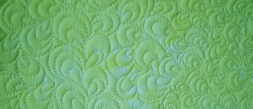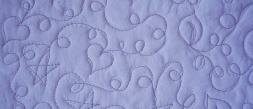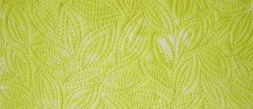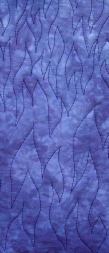




Machine quilting is a fun part of the whole quilting process, but if you are a piecer
or appliquer more so than a quilter, you can bring your quilt to be Machine Quilted,
for quotes on price and more info click here, or you can email me.
Some things to consider before bringing your top to be quilted:
- Do not baste or pin your quilt sandwich, bring three separate items - top, batting
and backing. Mark the top and backing if it is directional.
- Your quilt should be pressed, squared and stray threads cut. These services can
be provided for an extra fee.
- Trimming selvage before piecing the backing with a 1/2” seam and ironing the seam
open will improve the appearance of the finished quilt.
- Backing should measure 8” larger and the batting 6” larger than the top in width
and length (I.e. 4”and 3” each side)
- If you have pieced borders or pieced blocks to the edges of your quilt, stabilize
the edges with stay stitching 1/8” from the edge all around the quilt.
Stippling and loop-d-loops
Loop-d-loops with Aztec patterns attached
Loop-d-loops with leafs, hearts and stars







- Always start a new project with a fresh needle.
- Match the size of the needle
to the weight of the tread.
When machine quilting, I like to use a Top-Stitch needle.
- Test your thread and tension on a scrap sandwich, different thread, fabric
and batting, all can make a difference in your final project.
- When experience skipped stitching: change to a fresh needle. You may have
the wrong needle for the fabric or thread you are using, batiks and other
tightly woven fabrics require a Microtex Sharp needle, the point is fine and
sharp and the needle will go through the fabrics that much easier.
- Batting has a right and wrong side.
When layering your quilt make sure to place your batting so that the dimples
are up and the pimples are down.
- When using metallic thread, try using an Embroidery or Topstitch needle with
a very smooth fine polyester thread in the bobbin. Because the thread is
partial and the needle is all metal, they both will heat up and can cause thread
breakage, take a break to let it, and you:) cool down.
- My personal preference needle for general sewing and most machine quilting
with regular polyester threads is the universal 70/10 or 80/12 needle
- Don’t be afraid to try anything, if it works, use it!
Tips about machine quilting:













